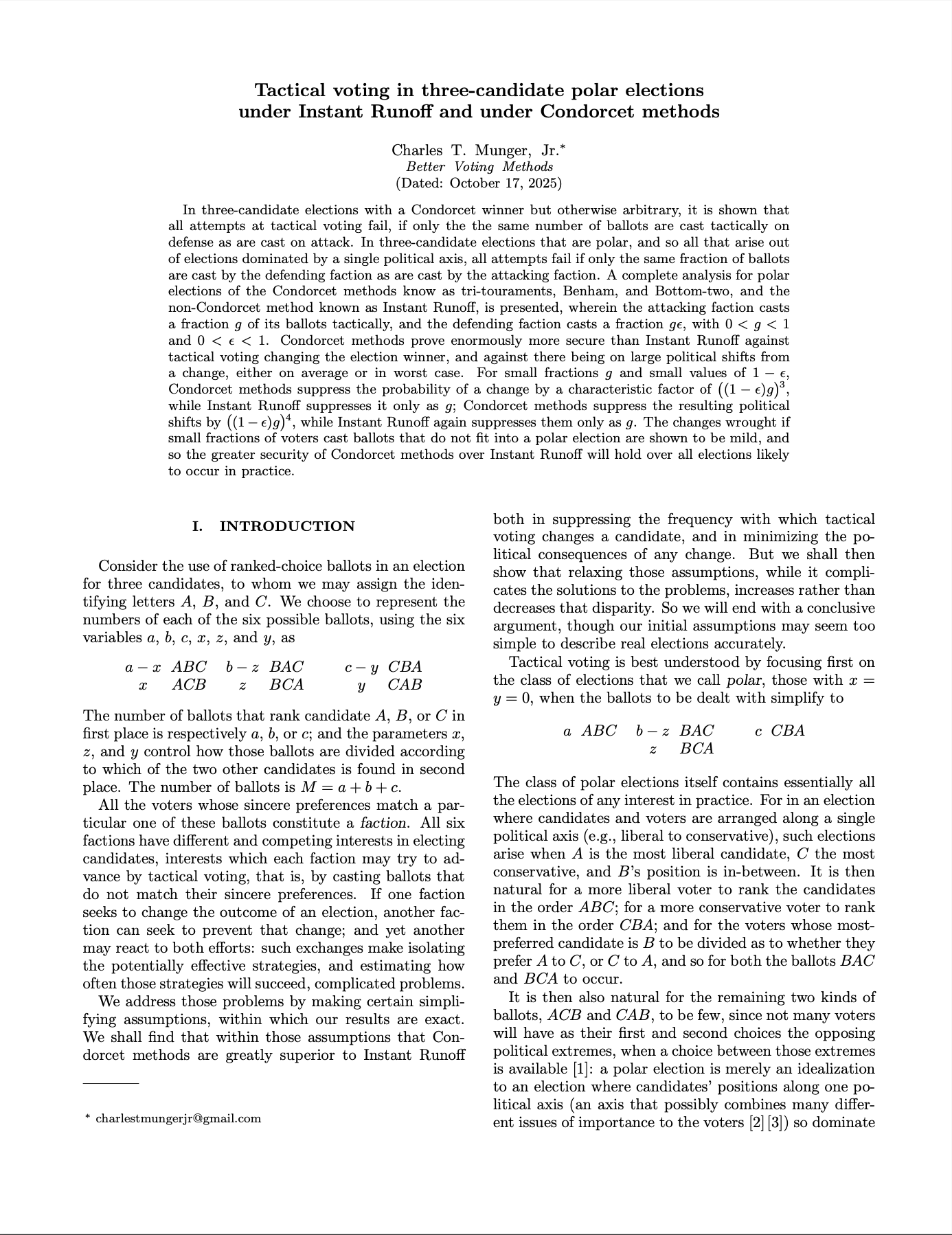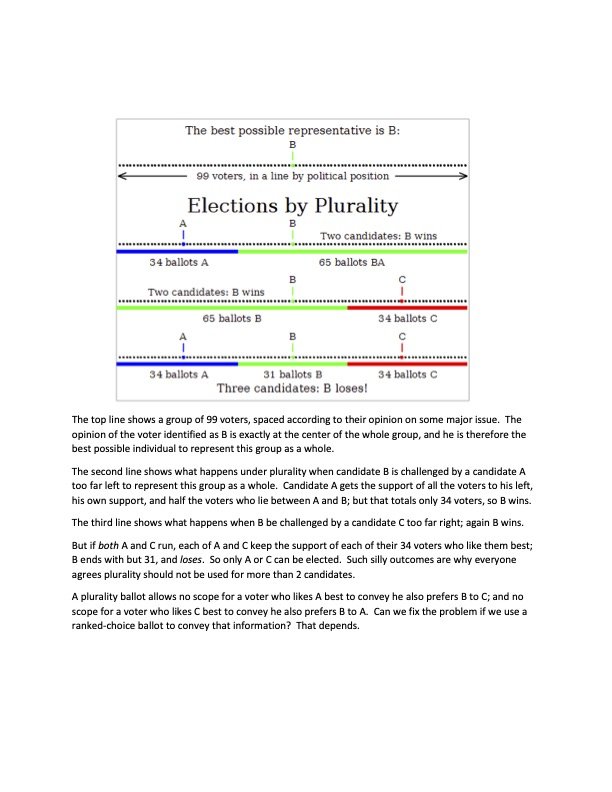Condorcet Versus Instant Runoff
CONDORCET METHODS VS. INSTANT RUNOFF
Summary: In three-candidate elections with a Condorcet winner but otherwise arbitrary, it is shown that all attempts at tactical voting fail, if only the the same number of ballots are cast tactically on defense as are cast on attack. In three-candidate elections that are polar, and so all that arise out of elections dominated by a single political axis, all attempts fail if only the same fraction of ballots are cast by the defending faction as are cast by the attacking faction. A complete analysis for polar elections of the Condorcet methods know as tri-touraments, Benham, and Bottom-two, and the non-Condorcet method known as Instant Runoff, is presented, wherein the attacking faction casts a fraction g of its ballots tactically, and the defending faction casts a fraction gϵ, with 0 < g < 1 and 0 < ϵ < 1. Condorcet methods prove enormously more secure than Instant Runoff against tactical voting changing the election winner, and against there being on large political shifts from a change, either on average or in worst case. For small fractions g and small values of 1 − ϵ, Condorcet methods suppress the probability of a change by a characteristic factor of (1 − ϵ)g 3, while Instant Runoff suppresses it only as g; Condorcet methods suppress the resulting political shifts by (1 − ϵ)g 4, while Instant Runoff again suppresses them only as g. The changes wrought if small fractions of voters cast ballots that do not fit into a polar election are shown to be mild, and so the greater security of Condorcet methods over Instant Runoff will hold over all elections likely to occur in practice.
Summary: Two pages, with the simplest example I know of, to show what goes wrong when three candidates face each other under plurality or Instant Runoff; why a Condorcet rule is necessary. No mathematics is needed at all, only 500 words. If you are new to Instant Runoff or Condorcet methods, start with this.
Summary: The four linked papers A through D analyze how best to take ranked-choice ballots and choose a single winner. The analysis includes the different incentives each method offers to candidates, causes, and voters, seeking to win, particularly to the tactics of bracketing and strategic nomination; presents examples and proofs of how the different methods perform when voters opinions are described as ranging along more than one political axis; and how the different systems rate against all the various abstract criteria used to assess the worth of election systems. In sum, any tournament method is decisively better than Instant Runoff (also known as the Alternative vote, or the Hare method); and the best of the tournament methods is Ranked Pairs; it is argued that any tournament method better than Ranked Pairs is unlikely to exist, which given its ease of implementation, makes it the best choice if ranked-choice ballots are to be used. Ranked Pairs works whether voters preferences on their ballots are strict, or whether voters are permitted to rank candidates in equal groups. If Ranked Pairs is considered too different from Instant Runoff to adopt, two other runoff methods, the Direct Hybrid and the Benham method, may be used instead.
Summary: The four linked papers A through D analyze how best to take ranked-choice ballots and choose a single winner. The analysis includes the different incentives each method offers to candidates, causes, and voters, seeking to win, particularly to the tactics of bracketing and strategic nomination; presents examples and proofs of how the different methods perform when voters opinions are described as ranging along more than one political axis; and how the different systems rate against all the various abstract criteria used to assess the worth of election systems. In sum, any tournament method is decisively better than Instant Runoff (also known as the Alternative vote, or the Hare method); and the best of the tournament methods is Ranked Pairs; it is argued that any tournament method better than Ranked Pairs is unlikely to exist, which given its ease of implementation, makes it the best choice if ranked-choice ballots are to be used. Ranked Pairs works whether voters preferences on their ballots are strict, or whether voters are permitted to rank candidates in equal groups. If Ranked Pairs is considered too different from Instant Runoff to adopt, two other runoff methods, the Direct Hybrid and the Benham method, may be used instead.
Summary: The four linked papers A through D analyze how best to take ranked-choice ballots and choose a single winner. The analysis includes the different incentives each method offers to candidates, causes, and voters, seeking to win, particularly to the tactics of bracketing and strategic nomination; presents examples and proofs of how the different methods perform when voters opinions are described as ranging along more than one political axis; and how the different systems rate against all the various abstract criteria used to assess the worth of election systems. In sum, any tournament method is decisively better than Instant Runoff (also known as the Alternative vote, or the Hare method); and the best of the tournament methods is Ranked Pairs; it is argued that any tournament method better than Ranked Pairs is unlikely to exist, which given its ease of implementation, makes it the best choice if ranked-choice ballots are to be used. Ranked Pairs works whether voters preferences on their ballots are strict, or whether voters are permitted to rank candidates in equal groups. If Ranked Pairs is considered too different from Instant Runoff to adopt, two other runoff methods, the Direct Hybrid and the Benham method, may be used instead.
Summary: The four linked papers A through D analyze how best to take ranked-choice ballots and choose a single winner. The analysis includes the different incentives each method offers to candidates, causes, and voters, seeking to win, particularly to the tactics of bracketing and strategic nomination; presents examples and proofs of how the different methods perform when voters opinions are described as ranging along more than one political axis; and how the different systems rate against all the various abstract criteria used to assess the worth of election systems. In sum, any tournament method is decisively better than Instant Runoff (also known as the Alternative vote, or the Hare method); and the best of the tournament methods is Ranked Pairs; it is argued that any tournament method better than Ranked Pairs is unlikely to exist, which given its ease of implementation, makes it the best choice if ranked-choice ballots are to be used. Ranked Pairs works whether voters preferences on their ballots are strict, or whether voters are permitted to rank candidates in equal groups. If Ranked Pairs is considered too different from Instant Runoff to adopt, two other runoff methods, the Direct Hybrid and the Benham method, may be used instead.
Summary: Condorcet-compatible election methods are examined and compared. The Ranked Pairs method proves significantly better than Beatpath; that both are clone-free, and have other desirable properties, makes them much better than any alternative.
Summary: The concept of spoilers, as defined by Fairvote, is analyzed and demonstrated to be useless for deciding whether Instant Runoff or either of the clone-free, Condorcet methods of Beatpath or Ranked Pairs is a better method to decide elections that use ranked-choice ballots. The problem of finding all patterns of ballots that generate spoilers that are not merely clones is solved for the general case of 4 candidates, and for 4 candidates restricted to a spatial model in two dimensions.
Summary: Opportunities for tactical voting using ranked-choice ballots are examined for three-candidate elections under Instant Runoff, and under the Condorcet runoff method known as Benham. The Benham method is shown to have strictly fewer opportunities for unilateral tactical voting, as follows. If an election offers an opportunity under Benham, then it also offers an opportunity under Instant Runoff; but the converse is not true: there are elections that offer an opportunity under Instant Runoff that do not under Benham.
Summary: A verbatim copy of the material posted by Fairvote on why Instant Runoff (which they call Ranked Choice Voting, or RCV) is inferior to a Condorcet method, interlineated however with my analysis of all the errors, which when corrected reverse the Fairvote conclusion.










